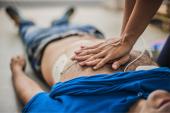Cooling OHCA Patients to 31°C Not Superior to 34°C: CAPITAL-CHILL
It’s possible there’s not a single target temperature that provides “what the brain really needs” for all patients, the investigator says.

Cooling patients who are comatose after out-of-hospital cardiac arrest (OHCA) to 31°C rather than 34°C doesn’t improve their prognosis over 6 months, data from the randomized, double-blind CAPITAL-CHILL trial show.
Current guidelines recommend that targeted temperature management (TTM) should fall in the range between 32°C and 36°C.
But as is true for many aspects of OHCA care, the optimal temperature has remained unclear, said investigator Michel R. Le May, MD (University of Ottawa Heart Institute, Canada), who presented the CAPITAL-CHILL results at the recent American College of Cardiology (ACC) 2021 Scientific Session. For instance, also at ACC, the Prague OHCA trial endorsed a “hyperinvasive” approach to the condition, which continues to have notoriously poor outcomes.
CAPITAL-CHILL “is the first randomized controlled trial to evaluate the benefits of therapeutic hypothermia with a target temperature below 32°C,” Le May told ACC’s virtual attendees.
Michael Mooney, MD (Minneapolis Heart Institute Foundation, MN), who had been awaiting the trial’s findings, commented on the new data for TCTMD. Ever since the negative TTM trial came out in 2013, he said, there’s been debate over how various approaches to cooling OCHA patients might bear fruit. CAPITAL-CHILL continues that discussion by taking “a relatively uniform approach to hypothermia” done in a single healthcare system, Mooney observed, “so there’s a lot less noise.”
Looking at the entire body of evidence, he said, “you have to wonder if the major benefit of therapeutic hypothermia was in saying to all the practitioners: ‘Don’t give up on these patients, and prevent fevers. And if you stay in the game doing your [best] neurological hygiene, hemodynamic support, and ventilator support, you can get these patients to survive at rates that you thought were not possible.’ I think that’s the fundamentals of it.”
All of this discussion serves as a “reminder to stay in the game and not assume a uniformly poor outcome” with OHCA, he stressed.
“I think [CAPITAL-CHILL] was able to pull that off,” he added. “And it’s a relief to many practitioners that they know they don’t have to go down to low temperatures now,” because there’s the worry that more-extreme hypothermia could potentially block response to vasopressors, interfere with platelet function, and decrease heart rate, Mooney explained. “[Clinicians can now] know that they’re still doing their best for their patients without taking things to a razor-thin line of: how low can I really go?”
CAPITAL-CHILL
Between 2013 and 2020, the investigator-driven CAPITAL-CHILL trial enrolled 389 patients who were successfully resuscitated but comatose after OHCA. Researchers at the University of Ottawa Heart Institute first stratified these individuals according to whether they had presented with shockable or nonshockable rhythm. They then randomized patients within each cohort to receive endovascular cooling with a target temperature of either 31° or 34°C for 24 hours, after which all were warmed to normal body temperature at a rate of 0.25° per hour. Rewarming took place over 24 hours in the 31°C group and over 12 hours in the 34°C group. Then patients were maintained at 37°C for an additional 24 hours.
For blinding, physicians were blocked by a shield covering the machine’s temperature and nurses kept separate charts with temperature details.
The modified intention-to-treat analysis included 184 patients cooled to 31°C and 183 cooled to 34°C. Clinical characteristics were well balanced. Mean age was around 60 years, and approximately 82% of the participants were men, 84% had bystander-witnessed cardiac arrest, 69% had bystander-performed CPR, and 86% presented with shockable rhythm. Mean lactate level was 4.5 mm/L, and four in 10 received inotropes/pressor agents. Slightly more than a third had STEMI. Median time from arrest to return of spontaneous circulation was around 20 to 23 minutes, and about 3.5 hours passed between arrest and randomization.
Nearly all patients (97%) underwent angiography and almost 60% had PCI, with half receiving stents. Intra-aortic balloon pumps were used in 6% of the 31°C patients and 11% of the 34°C patients. On average, it took 3 hours and 2 hours for each group, respectively, to get to target temperature.
[Clinicians can now] know that they’re still doing their best for their patients without taking things to a razor-thin line of: how low can I really go? Michael Mooney
All-cause death and poor neurological outcome (Disability Ratings Scale score > 5) at 6 months, the study’s primary endpoint, occurred at similar rates in the 31°C group and the 34°C group (48.4% vs 45.4%), as did the individual components (death 43.5% vs 41.0%; poor neurological outcome 4.9% vs 4.4%). Outcomes didn’t differ by sex, age, initial rhythm, STEMI status, and PCI within 12 hours.
There also were no significant differences in the secondary outcomes of pneumonia, renal replacement therapy, seizure, and stroke. Bleeding and thrombosis rates, too, were equal. Median length of stay in the cardiac intensive care unit was longer for the 31°C group than for the 34°C group (10 vs 7 days; P = 0.004), although the overall stay in the cardiac center didn’t differ.
An Eye Toward Tailored Care
Jeanne E. Poole, MD (UW Medicine, Seattle, WA), discussant for CAPITAL-CHILL, praised the trial’s exploration of a “very low temperature” and its randomized, double-blinded design, as well as the use of endovascular cooling, an approach that “minimizes the time to target temperature” while offering precision. “All of these points support the validity of your findings of no difference in the primary or key secondary outcomes,” said Poole.
She drew attention toward the nonsignificant trends suggesting that, compared with the 34°C target, 31°C carries numerically higher rates of stroke (4.4% vs 1.6%; P = 0.22), seizure (12.5% vs 7.1%; P = 0.08), and TIMI major bleeding (23.4% vs 19.7%; P = 0.39). “It will likely take a larger trial to know if these differences are actually clinically important,” she commented. Pneumonia risk also was slightly elevated in the lower-temp group (67.4% vs 63.4%; P = 0.42), Poole pointed out. “We know that patients who are cooled longer tend to be ventilated longer, and this might have contributed to that higher rate.”
Moving forward, she suggested, studies should look into variables like the potential effects of TTM timing on outcomes (eg, whether it starts with ice packs in the emergency department or endovascular cooling in cath lab). There’s also the question of whether temperature should be adjusted to ischemic time.
[Future trials should] try to understand how the brain is deprived—whether it needs a better stroke volume, better cardiac output, a different temperature. Michel R. Le May
“Your study may have taken off the table now very low temperatures for further investigation,” said Poole, but she also noted that major gaps in knowledge mentioned in the 2015 American Heart Association TTM guidelines are still unanswered. Results from TTM-2 and ICECAP are on the way.
Le May agreed that CAPITAL-CHILL, which he described as “neutral,” is just one among the family of completed or ongoing TTM trials. Forthcoming data may provide insight, he concurred, and it’s possible there’s not a single target temperature that provides “what the brain really needs” for all patients. Future trials should “try to understand how the brain is deprived—whether it needs a better stroke volume, better cardiac output, a different temperature,” each of which might help tailor treatment, Le May concluded.
Le May told the media in a press briefing that his study, though negative, “gives us the bar of how low you can go,” in that there were some downsides associated with 31°C, like a longer length of stay. “Right now I think it’s a bit of a dealer’s choice, in terms of what you want to choose [for] temperature,” said Le May, noting that guidelines differ slightly in their recommended ranges. Canadian guidelines set the range at 33° to 36°C, for example, out of concern that 32°C might go too far.
Caitlin E. Cox is News Editor of TCTMD and Associate Director, Editorial Content at the Cardiovascular Research Foundation. She produces the…
Read Full BioSources
Le May MR. Therapeutic hypothermia following out-of-hospital cardiac arrest: a randomized trial comparing mild and moderate therapeutic hypothermia. Presented at: ACC 2021. May 17, 2021.





Comments